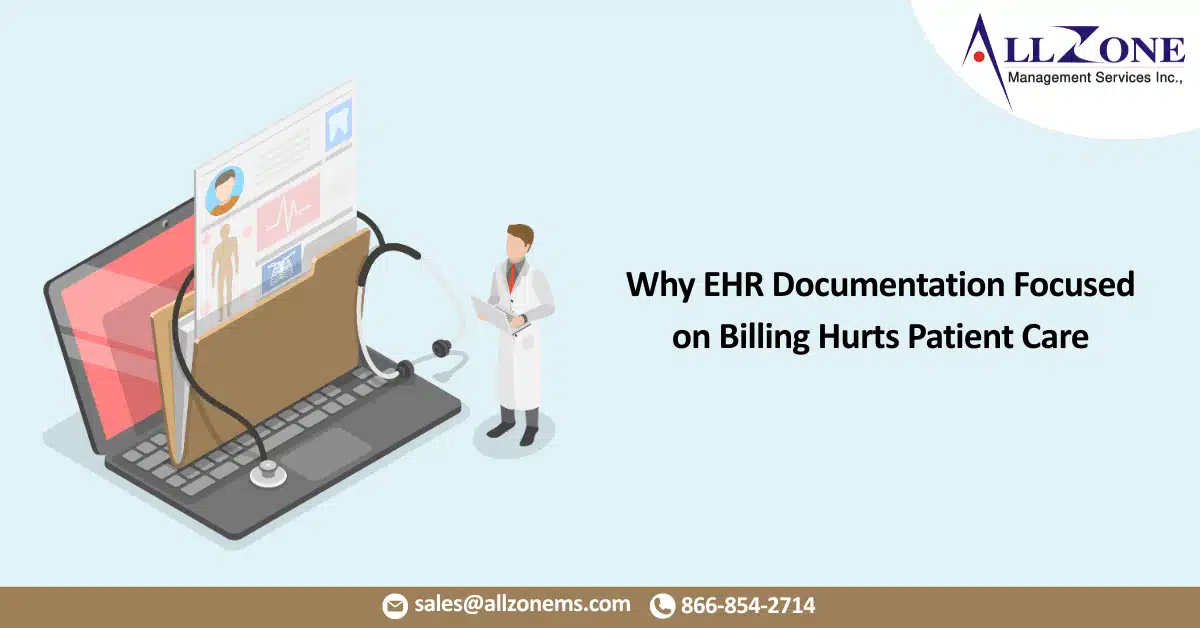Electronic Health Records (EHRs) have revolutionized healthcare documentation, promising efficiency, improved patient care, and streamlined billing. However, in recent years, many healthcare providers have voiced a significant concern: EHR documentation focused on billing has become too prevalent, often at the expense of clinical care. This shift toward reimbursement-centric documentation has led to clinician burnout, reduced patient engagement, and increased administrative burden.
In this blog, we’ll explore the implications of EHR documentation focused on billing, its impact on healthcare providers and patient care, and what steps the industry can take to rebalance EHR usage.
The Original Purpose of EHRs
EHR systems were initially designed to support clinical documentation, facilitate care coordination, and improve patient outcomes. They were meant to be tools that enable physicians to easily access patient histories, lab results, medications, and treatment plans—ultimately enhancing decision-making at the point of care.
However, with the growing complexities of healthcare reimbursement models, EHR documentation focused on billing has evolved into platforms that heavily prioritize billing and coding compliance. This shift has led to significant unintended consequences.
How Billing-Focused Documentation Impacts Providers
1. Clinician Burnout
One of the most pressing issues with billing-centric documentation is the increased time physicians spend on data entry. Studies show that physicians spend nearly two hours on EHR tasks for every one hour of direct patient care. This imbalance contributes to:
- Mental fatigue
- Decreased job satisfaction
- High rates of burnout
Instead of focusing on patient interactions, providers find themselves crafting notes that meet evaluation and management (E/M) coding requirements, often filled with irrelevant details to justify billing levels.
2. Note Bloat and Clutter
To satisfy billing documentation standards, EHRs are often filled with lengthy, templated notes that obscure meaningful clinical information. This phenomenon, known as “note bloat,” results in:
- Difficulty identifying critical patient data
- Increased time spent reviewing charts
- Risk of overlooking key clinical insights
Physicians frequently copy and paste large portions of previous notes or use templates that prioritize billing codes over clinical relevance.
3. Compromised Patient Care
When EHR documentation emphasizes billing, patient-centered care can suffer. Providers may:
- Spend less time making eye contact and engaging with patients
- Prioritize what gets documented for reimbursement rather than what is clinically significant
- Struggle to capture the patient’s story authentically
This approach diminishes the quality of the provider-patient relationship and may impact care decisions.
Compliance vs. Clinical Accuracy: Finding the Balance
Healthcare providers operate in a system where accurate documentation is essential not only for quality care but also for regulatory compliance, risk management, and appropriate reimbursement. However, the scale has tipped too far toward financial and legal justifications.
The Centers for Medicare & Medicaid Services (CMS) has acknowledged this issue and has made efforts to reduce documentation burden with changes to E/M guidelines in 2021. These changes allow providers to document based on medical decision-making or total time spent, rather than requiring lengthy bullet-point histories. While a step in the right direction, more work is needed.
The Role of EHR Vendors and System Design
EHR vendors play a critical role in the current billing-focused documentation culture. Many systems are built with billing and compliance as the primary goals, incorporating:
- Automated code suggestion tools
- Templates geared toward maximizing revenue
- Prompts to include redundant information to support higher billing levels
These design choices can inadvertently encourage providers to “document to code” rather than “document to care.” There’s a growing call for user-centered design that puts clinical usability first and supports the natural workflow of clinicians.
Strategies to Rebalance EHR Documentation
To realign EHR usage with its original intent—supporting patient care—healthcare organizations and technology vendors must take coordinated steps:
1. Redesign EHR Interfaces
- Prioritize clinical decision support tools over billing prompts
- Reduce unnecessary fields that don’t contribute to care quality
- Improve navigation and search functionalities to highlight key clinical data
2. Adopt Scribe or Voice Recognition Technology
- Use virtual scribes or dictation tools to reduce data entry burden
- Allow clinicians to focus more on patient interaction and less on typing
3. Educate Providers on New Documentation Guidelines
- Train staff on recent E/M coding changes to avoid overdocumentation
- Encourage a culture of quality care rather than volume-based billing
4. Implement Value-Based Care Models
- Shift focus from fee-for-service to value-based reimbursement
- Encourage documentation that supports care quality and outcomes, not just payment levels
5. Engage in Continuous Feedback Loops
- Solicit regular feedback from end-users (clinicians) to identify pain points
- Partner with IT and compliance teams to find acceptable documentation shortcuts without sacrificing compliance
Real-World Consequences: A Provider’s Perspective
Many physicians report feeling like “data entry clerks” rather than healers. In one real-world example, a primary care provider noted that their patient visits now require over 20 minutes of post-visit EHR documentation focused on billing to satisfy billing requirements—time that could otherwise be used to review labs, follow up on care plans, or communicate with patients.
This pressure is even greater in specialties that rely on high volumes, such as family medicine, internal medicine, and pediatrics. In these settings, every minute counts, and every click adds up.
Conclusion: A Call for EHR Reform
The current state of EHR documentation reflects a healthcare system where EHR documentation focused on billing often outweighs clinical relevance. While accurate coding is essential, the pendulum has swung too far. Healthcare leaders must take steps to ensure that EHRs serve their primary purpose: supporting safe, effective, and patient-centered care.
By embracing more intuitive EHR designs, reducing unnecessary documentation requirements, and training providers on streamlined compliance strategies, the healthcare industry can shift away from documentation overload—and toward meaningful, efficient clinical care.

